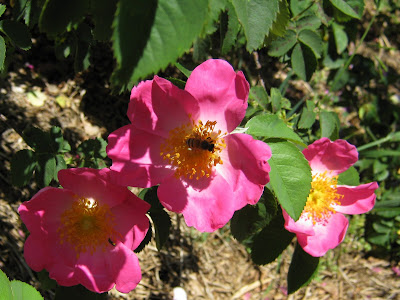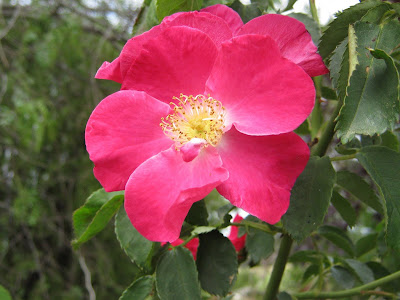
I just adore the Kordes-raised "Fruhlings" roses, or at least the three that I know and love first-hand...Fruhlingsgold(above), Fruhlingsmorgen and Fruhlingsduft. There is another, by the hefty name of 'Fruhlingsanfang', which I am going to chase up for next year's bareroot order.
Related as they are to the old Spinosissima roses (also known as Scotch roses), these roses give the most brilliant Spring displays, and are nice-looking garden shrubs even when they are not in flower. The bees absolutely love them when they are blooming.
My Fruhlingsgold is the biggest of the three that I grow- he is easily eight feet tall and the same in width. No support is needed, and the flowers are very fragrant

Above: Fruhlingsgold ( 'Fruhling' meaning 'spring')

Frulingsgold.

Above: The glorious Fruhlingsduft, which I purchased many years ago mis-labelled as 'Constance Spry'. This rose isn't as rampageous as its siblings Fruhlingsgold and Fruhlingsmorgen, but is still a large arching shrub rose that appears to be totally disease free.

Fruhlingsduft ("Scent of Spring')

Above: Fruhlingsduft showing the lovely golden-tipped pinkish-maroon stamens in the centre of the bloom.

Above: My specimen of Fruhlingsmorgen which grows intertwined with Fruhlingsgold. They both flower at the same time in October, and the effect is stunning.

Above: The sweet and simple blooms of Fruhlingsmorgen ("Spring Morning")
 Above; One of several plants of Rosa Manettii that have established themselves in the garden.
Above; One of several plants of Rosa Manettii that have established themselves in the garden. Above: Rosa Manettii
Above: Rosa Manettii Above: Roy Rumsay's Multiflora makes a fabulous garden shrub that cascades with bloom every October-November.
Above: Roy Rumsay's Multiflora makes a fabulous garden shrub that cascades with bloom every October-November. Above: Roy Rumsay's Multiflora.
Above: Roy Rumsay's Multiflora.










 Above: The line of ramblers minus their gum trees. In the foreground is Silver Moon just beginning to spot flower. We are hoping that the ramblers will build themselves up into self-supporting mounds now that their gum tree support is gone.
Above: The line of ramblers minus their gum trees. In the foreground is Silver Moon just beginning to spot flower. We are hoping that the ramblers will build themselves up into self-supporting mounds now that their gum tree support is gone. Above: Some of the ramblers that were planted under a line of Prunus trees. Although most of the original prunus trees have died, the understock trees which they were grafted onto have survived and are doing beautifully (truth be told, I like these better than the maroon -leaved pink-flowering variety that was grafted onto them)
Above: Some of the ramblers that were planted under a line of Prunus trees. Although most of the original prunus trees have died, the understock trees which they were grafted onto have survived and are doing beautifully (truth be told, I like these better than the maroon -leaved pink-flowering variety that was grafted onto them)




































 Above: Buff Beauty
Above: Buff Beauty




